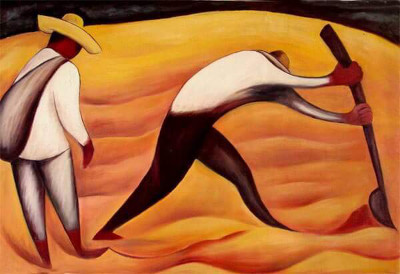Diego Rivera captured peasants many times within his career, with this example likely to have been produced in the year 1947, although there have been some suggestions that it was actually from several years earlier than that.
Scenes of peasants at work hold a symbolic and aesthetic value to artists and so also appear in the work of a number of other famous artists. Kazimir Malevich, for example, would depict the lives of these hard working individuals within his highly abstract style and again there was also a connection to socialist politics in his work, just as with Rivera. The physical toil experienced by people working out in the fields would perfectly symbolise the endless struggle felt by those towards the bottom of society and so these scenes were far more than simply displaying individuals at work within the artist's local community. Notice in Rivera's version, probably from 1947, how the focus is on the physical effort of the figure to the right, as he works hard to drag his tool across the ground, whilst a colleague looks on. Rivera became known as a Social Realist artist precisely due to items such as this.
Rivera provides an emotional style for this painting, where detail is suggested at rather than being delivered with precision. There is no realism in a technical sense, but he does focus on the lives of those at the bottom of society. The landscape is separated into two main areas, which contrast completely through the use of colour. The very top is black, with the foreground being a bright yellow tone which captures the plant that these farmers were growing. Within that are then waves of orange that provide the image of rows of crops which have been carefully crafted by these farmers over the preceding months and years. Their clothing is simple and chosen specifically for the tasks at hand, which includes long days out in the hot sun, hence the wide brimming hats and long sleeves shirts. The length of the farming tool also appears possibly oversized as a means to really getting across the point of the hardwork being performed in these physical tasks.
The lives of rural peasants really captured the essence of Mexican life, both the struggle, but also the joy of working for the basics of life. These scenes could also easily incorporate the bright tones found within Mexico's environment and therefore were patriotic in message. There was no negativity within these depictions, but rather a pride of the country, where people worked hard to feed themselves and others. Rivera also wanted to attract more attention to the lives of normal people so that they could start to receive more help, which he felt they needed and also deserved. Progress would be made within Mexico during Rivera's lifetime and perhaps his worked helped a little to bring that about.




